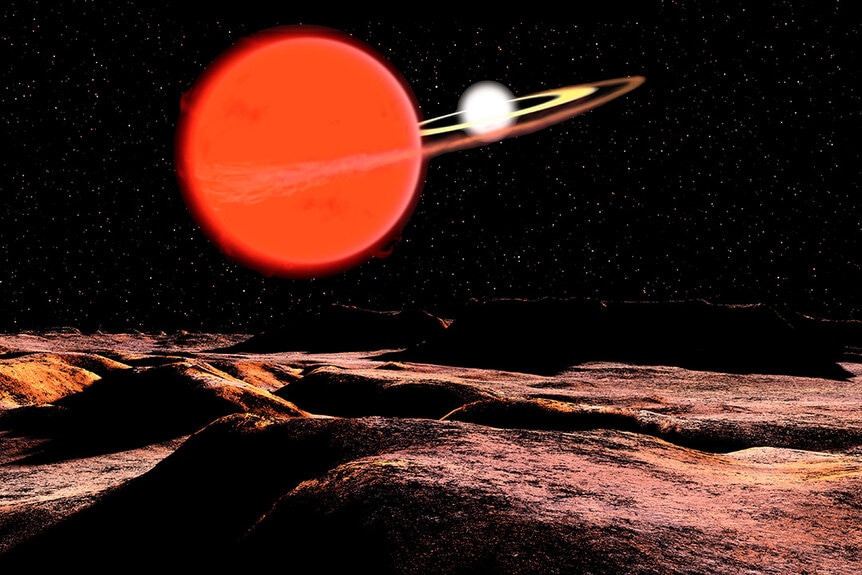Create a free profile to get unlimited access to exclusive videos, sweepstakes, and more!
A “Forbidden Planet” Might Have Been Born from the Ashes of Its Star
A new world at the edge of destruction.
Nothing lasts forever, not even worlds. For our species to continue existing for the long-term, we might have to spread our eggs to a few different planetary baskets, like the brave explorers of SYFY's The Ark, streaming now on Peacock. They’re headed to Proxima centauri, a nearby red dwarf star about 4.2 lightyears from here. Because red dwarfs are less massive, they have a weaker gravitational field and emit less heat and light. Consequently, their planets tend to hang out close in and orbit quickly. Proxima centauri b, for instance, is only 0.048 astronomical units (AU: the average distance between the Earth and the Sun) and completes an orbit every 11.2 (Earth) days.
Living on Proxima centauri b would be pretty different from living on Earth, but it would at least be the kind of existence we sort of recognize. Recently, astronomers found a planet orbiting another kind of red star, and we’re not totally certain how it exists at all. The results of its study were published in the journal Nature.
How Stars Die (Usually)
When a star dies, we expect one of a few things to occur, depending on their mass. Maybe they explode in a dramatic supernova or collapse into a black hole. Maybe they have a quieter death, but no matter what the end stages look like, it all comes down to running out of fuel.
RELATED: Astronomers Find a “Forbidden Planet” Orbiting an Impossibly Tiny Star
For Sun-like stars, like 8 Ursae minoris, the sequence of events goes something like this. Stars like the Sun spend most of their lives comfortably fusing hydrogen into helium inside of their cores. The biproducts of that process, heat and light, are what make for sunny summer days. After 10 billion years or so, a star runs out of hydrogen in its core and things get weird.
During the main phase of their lives, the inward pull of gravity is nicely balanced by the outward thermal pressure of fusion. When fuel runs low and fusion starts to stutter, however, gravity gets the upper hand, and a star will shrink dramatically. Compression has a handy consequence of raising the heat and pressure in the core until the conditions inside are intense enough to start fusing helium into carbon and oxygen. Suddenly, the power imbalance flips the other way and the heat and pressure inside the core cause the star’s outer layers to balloon and swell.
When that happens in our own system, the Sun will consume Mercury, Venus, and maybe the Earth. Astronomers aren’t certain of that point but whatever happens it will be a bad day for the Earth. Eventually, helium fusion inside the swollen star slows down and gravity takes the lead once more. Then the whole cycle starts over again. These are the last gasps of a dying star struggling to keep the fires lit. By the end, the outer layers are shed entirely leaving only a slowly cooling white dwarf behind.
That’s the ultimate fate of our solar system and countless Sun-like stars polka-dotting the cosmos. At 93 million miles distance, our planet might escape the fiery appetite of the Sun’s death throes, but barely. Planet’s closer in shouldn’t stand a chance. Unless…
Halla, the Planet that Forgot to Die
Over the last couple of decades, astronomers have been busy discovering worlds around other stars at a breakneck pace. To date, more than 5,000 exoplanets have been discovered and none of them are orbiting within the blast zone of a post-expansion red giant. At least, that would be true if not for Halla.
It’s about 1.31 times the mass of Jupiter and orbiting close in, at about half the distance between the Earth and the Sun, or 0.5 AU. These so-called hot Jupiters aren’t at all uncommon, but Halla is special. It was first discovered in 2015, but astronomers didn’t notice something was unusual until they got additional observations using NASA’s Transiting Exoplanet Survey Satellite (TESS). Through careful study, astronomers realized that Halla’s star is in the process of dying as we speak, and Halla is orbiting in the middle of the crime scene.
RELATED: What Happens When a Star Engulfs Its Planets?
Its star has already gobbled up the available hydrogen and is currently fusing helium. Models of the star suggest that this isn’t its first blow up either. It has expanded to a distance of roughly 0.7 AU at least once before. Considering how closely Halla orbits, well inside that 0.7 AU boundary, it should have been swallowed the first time the star got swole. And, yet Halla persists.
Astronomers suggest a couple of potential explanations for the bizarre existence of Halla, both of which involve cannibalizing another star. It’s possible that Halla was orbiting a binary star system which merged into a single star. A late-stage midnight snack could give a star a burst of fuel and prevent it from ballooning quite as much as it otherwise might have. Halla may have survived because some other cosmic object jumped in front of the proverbial bullet on its behalf.
Alternatively, Halla may not have existed at all before its star started spinning down the drain. If Halla’s star did recently (astronomically speaking) consume a binary companion, the aftermath of the merger may have created Halla. In this model, Halla is a second generation planet formed by the debris field left over by the stellar collision.
A merger could also help explain the star’s unusually high levels of lithium, something not usually expected in stars of this kind, but which might form during a cosmic dust up. One thing is certain, the universe is weirder than we imagine, and it is under no obligation to play by our rules.
Catch the complete first season of The Ark, streaming now on Peacock!




































